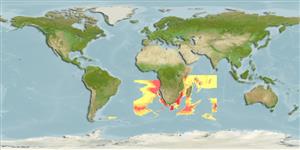Élasmobranches (requins et raies) (sharks and rays) >
Squaliformes (Sleeper and dogfish sharks) >
Etmopteridae (Lantern sharks)
Etymology: Etmopterus: Greek, ethmos, -ou = sieve or ethmoides bone + Greek, pteron = wing, fin (Ref. 45335); sculptus: The species name derives from the Latin sculpo, in allusion to the carved or sculpted appearance of its linear denticles (Ref. 87957).
Environment: milieu / climate zone / depth range / distribution range
Écologie
marin bathydémersal; profondeur 240 - 1023 m (Ref. 106604). Deep-water
Southeast Atlantic and Southwest Indian Ocean: Namibia to southern Mozambique,
and Madagascar Ridge.
Length at first maturity / Taille / Poids / Âge
Maturity: Lm ?, range 42 - ? cm
Max length : 59.0 cm TL mâle / non sexé; (Ref. 106604); 51.5 cm TL (female)
Description synthétique
Morphologie | Morphométrie
Etmopterus sculptus is a moderately large, stout, species of linear-denticled Etmopterus, which separates it from most other members of this genus, and can be distinguished from its three closest congeners within the E. Lucifer-group, E. brachyurus, E. lucifer, and E. molleri, by the length of its anterior flank markings being slightly longer than its posterior branch. The posterior branch of the flank markings on E. brachyurus and E. molleri are shorter relative to the anterior branch, and in E. lucifer, the anterior branch is nearly twice the length of the posterior branch. The new species can also be distinguished from its closest congeners by the arrangement of dermal denticles that extend over most of the upper and lower body surface. Etmopterus sculptus possesses non-overlapping denticles, giving it a rougher, more sculpted texture than these other aforementioned species. The arrangement of the dermal denticles onthe ventral head surface is also a good character for separating these species, with E. sculptus having uniformly distributed denticles while the ventral surface of E. Lucifer and E. molleri is sparsely covered with denticles. The ventral surface of the head of E. brachyurus typically lacks dermal denticles (Ref. 87957).
This species is fairly common along the upper continental slopes between Namibia and southern Mozambique (Ref. 87957); upper slope, on or near the bottom (Ref. 5578). Observed mostly at depths between 450 and 900 m (Ref. 27644), but with records as shallow as 240 m (in Bass et al., 1976: listed as E. lucifer) (Ref. 87957). Feeds mainly on mid-water bony fish, also squid, octopus, shrimp and brittle stars (Ref. 5578).
Life cycle and mating behavior
Maturité | Reproduction | Frai | Œufs | Fécondité | Larves
Bears 2 young (Ref. 5578). Distinct pairing with embrace (Ref. 205).
Ebert, D.A., Compagno, L.J.V. and M.J. De Vries, 2011. A New Lanternshark (Squaliformes: Etmopteridae: Etmopterus) from Southern Africa. Copeia 2011(3):379-384. (Ref. 87957)
Statut dans la liste rouge de l'IUCN (Ref. 130435)
Menace pour l'homme
Harmless
Utilisations par l'homme
Plus d'informations
Taille/ÂgeCroissanceLongueur-poidsLongueur-longueurFréquences de longueursMorphométrieMorphologieLarvesDynamique des populations larvairesRecrutementAbondanceBRUVS
RéférencesAquacultureProfil d'aquacultureSouchesGénétiqueElectrophoresesHéritabilitéPathologiesTraitementNutrientsMass conversion
CollaborateursImagesStamps, Coins Misc.SonsCiguateraVitesseType de nageSurface branchialeOtolithesCerveauxVision
Outils
Articles particuliers
Télécharger en XML
Sources Internet
Estimates based on models
Preferred temperature (Ref.
123201): 1.9 - 8, mean 2.3 °C (based on 14 cells).
Phylogenetic diversity index (Ref.
82804): PD
50 = 0.5000 [Uniqueness, from 0.5 = low to 2.0 = high].
Bayesian length-weight: a=0.00380 (0.00191 - 0.00758), b=3.09 (2.92 - 3.26), in cm total length, based on LWR estimates for this Genus-body shape (Ref.
93245).
Niveau trophique (Ref.
69278): 4.3 ±0.6 se; based on size and trophs of closest relatives
Résilience (Ref.
120179): Faible, temps minimum de doublement de population : 4,5 à 14 années (Deep-water species with low fecundity (RF)).
Fishing Vulnerability (Ref.
59153): Moderate vulnerability (44 of 100).
